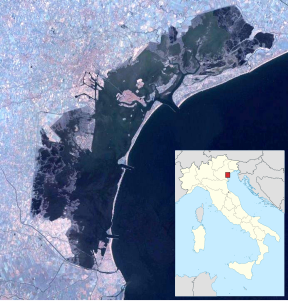San Giacomo in Paludo
| San Giacomo in Paludo | ||
|---|---|---|
| The island of San Giacomo in Paludo | ||
| Waters | Venice lagoon | |
| Geographical location | 45 ° 28 '10 " N , 12 ° 22' 45" O | |
|
|
||
| length | 123 m | |
| width | 101 m | |
| surface | 1.249 6 ha | |
| Highest elevation | 1 m | |
| Residents | uninhabited | |
San Giacomo in Paludo is an island in the Venice lagoon . It is located between the islands of Murano and Madonna del Monte on the Scomenzera San Giacomo canal and has an area of 12,496 m². In the High Middle Ages there was a hospice for pilgrims to the Holy Land, from the 13th to the 15th century a women's monastery, then Franciscans lived there. From the early 19th century, when the island was turned into an ammunition depot, until 1961, it was used for military purposes.
history
On the island, like on several other islands in the lagoon, Attic shards and those from Roman times were found that can only be explained by permanent settlement.
In 1046 Orso Badoer donated the island to Giovanni Trono from Mazzorbo in order to be able to build a monastery called San Giacomo Maggiore here, which became a point of contact for pilgrims on the initiative of Doge Pietro Polani . In 1238 the monastery went to Cistercian women , but the last two nuns went to the Santa Margherita Monastery on Torcello in 1440 .
In 1456 the monastery was temporarily used as a hospital , and in the 16th century it was taken over by the Franciscan Minorites . They restored the complex several times.
In 2002 excavations began on the island, which also included the monastery complex in the northeast of the island. To the east of it, already under water, there are other structures that were probably related to the monastery. The nuns and monks are likely to have built the canals, as well as the connecting paths from Cocciopesto (a mixture of potsherds and lime), from which the path between the 16th century church and the monastery was discovered. It became apparent that they had to raise and protect the buildings at greater intervals in order to counter the rising sea level. In 2003 the former cemetery was uncovered and two well-preserved corpses were discovered. The two men, 35 to 40 years old and around 1.75 m tall, were buried here. A rubbish pit was also found, the oldest pieces of which date from the 13th century. The "cavana dell'ortolano" mentioned in the sources was also discovered, a ship landing and repair station that existed from the 13th to the 17th century.
In 1810, after Napoleon had repealed the order, the monastery was given up. Under Austrian rule, the island was converted into a fortress and equipped with cannons. The Italian army used the island as an ammunition depot , for which three complexes were created. Until 1961 the decaying building was repeatedly used as a military post. The military installation is to be restored. The sale of the urban island for the purpose of converting it into a hotel is controversial (as of 2015).
literature
- Carlo Beltrame, Fulvio Baudo, Diego Calaon: Area 1000 e 2000: la chiesa di San Giacomo e il monastero delle fasi medievali e tardomedievali , in: Sauro Gelichi , Fulvio Baudo, Carlo Beltrame, Diego Calaon, Silvia Smyth: Isola di San Giacomo in Paludo (laguna north, Venezia): gli scavi delle campagne del 2003 (SGP03a, SGP03b) , in: Quaderni di Archeologia del Veneto 20 (2004) 160–177.
- Ernesto Canal : I ritrovamenti ceramici attici e di epoca romana in San Giacomo in Paludo, un isola da recuperare. Testimonianze di storia e archeologia di un'isola della laguna veneta , exhibition catalog Venice 1988, pp. 39–42.
- Sauro Gelichi : Archeologia e monasteri nella laguna veneziana: San Giacomo in Paludo , in: R. Fiorillo, P. Peduto (ed.), III Congresso Nazionale di Archeologia Medievale , Salerno 2003, pp. 243-270.
- Sauro Gelichi, Fulvio Baudo, Diego Calaon, Carlo Beltrame: Isola di San Giacomo in Paludo (laguna veneziana). Attività di ricognizione, rilievo, scavo e studio stratigrafico degli elevati, in: Anna Paola Zaccaria (ed.): Le missioni archeologiche dell'università Ca 'Foscari di Venezia , Venice 2004, pp. 97–110.
Remarks
- ^ Benedetta Rossignoli: L'Adriatico greco. Culti e miti minori , Rome 2004, p. 53, note 48.
- ↑ L'Isola di San Giacomo potrà essere venduta: la sentenza è del CdS , in: VeneziaToday, March 4, 2015.

